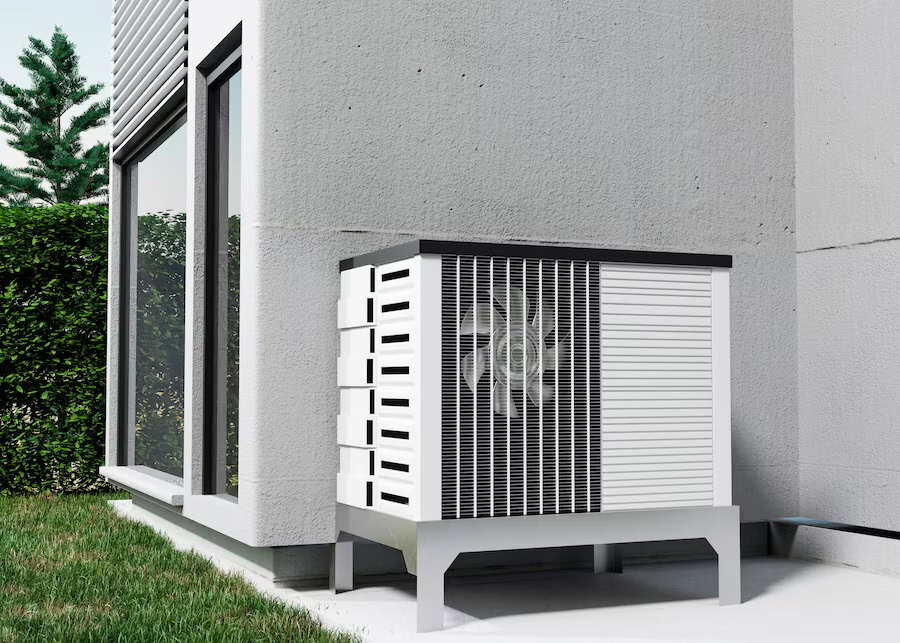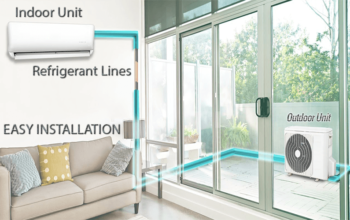Amana PTAC 15,000 BTU Heat Pump Unit 3.5kW Back Up Heater
We are going to start heat pump reviews consumer reports with this highly efficient heat pump from Amana, which has a decent energy output of 15,000 BTUs.
This is a 9.7 EER Heat Pump that can also be used as an air conditioner.
A powerful appliance, Amana has developed this heat pump for motels and hotels, but if you have a big house, then you can install this heat pump at home to stay warm during harsh winters.
The company has added a terminal air conditioner with a 3.5kW heat strip in the appliance, which makes it a lot more efficient.
The heat pump comes with a Digismart control board that allows maximum energy savings.
This is a reliable unit because you will get a 1-year replacement guarantee on it if anything goes wrong. Besides that, the company offers a 5-year limited parts warranty as well.
Goodman 3 Ton 14 Seer Heat Pump System With Multi-Position Air Handler
Goodman is not just known for its amazing fleet of furnaces, but also heat pump systems. Check out this particular model, which is a 3-ton 14 seer heat pump that keeps your entire property warm.
The appliance uses the HKSC/HKSX series of heat kits, which are much better than HKR series heat kits.
The heat pump uses a highly efficient scroll compressor and factory-installed high-capacity muffler.
The air handler is included in the package, which features a coil mounting track for fast repositioning.
The air handler comes in a rigid SmartFrame cabinet, which protects it from all sorts of damages.
The appliance uses R-410A as its coolant, which is widely common among air conditioners these days.
When it comes to the warranty, then the company offers a 10-year warranty on parts, but make sure to install the appliance from a qualified installer and register the product within 60 days of installation.
Goodman 3.5 Ton 15 Seer Heat Pump System With Multi-Position Air Handler
Get this heat pump, which comes with a 3.5-ton multi-position air handler and Thermal Expansion Valve (TXV) for a 3.5 – 5-ton R-410A.
The heat pump comes with a highly energy-efficient scroll compressor and a high-capacity muffler, which is installed from the factory.
You will also get an air handler in the package, which comes with an all-aluminum evaporator coil and the ability to configure in horizontal as well as vertical modes.
The cooling capacity of the unit is around 42,000 BTUs, but that doesn’t mean the unit will consume more energy.
This is one of the most energy-efficient heat pumps available on the market.
The company offers a 10-year warranty on parts, but make sure to install the appliance from a qualified installer and register the product within 60 days of installation.
The heat pump doesn’t come with accessories such as thermostats, line sets, and LP conversion kits, so you will have to buy these separately.
Goodman 2 Ton 15 Seer Heat Pump System With Multi-Position Air Handler
We have another product from Goodman, which is a 2-ton 15 seer heat pump system with a multi-position air handler.
The heat pump includes a highly-efficient scroll compressor and crankcase heater, which comes installed from the factory itself.
Then, comes the air handler, which incorporates a flowrator for cooling and heat pump applications.
The air handler also includes a coil mounting track for fast positioning. You will get a 10-year warranty on parts, provided you have installed the appliance from a qualified installer and registered the product within 60 days of installation.
The only downside to this unit is that it doesn’t come with accessories such as thermostats, line sets, and LP conversion kits, so you will have to buy them separately.
Goodman 2.5 Ton 14 Seer Package Heat Pump – GPH1430H41
We end our list of heat pump reviews consumer reports with another Goodman heat pump, which is a 2.5-ton 14-seer device that is capable of heating as well as cooling your premises in the quickest of times.
The system is horizontally configured for a wider spread of hot or cold air. The company has used R-410A coolant in this heat pump, which ensures faster and long-lasting cooling.
The heat pump comes with an energy-efficient scroll compressor and an evaporator coil that is made purely of aluminum.
The unit also features a completely enclosed and well-lubricated condenser fan motor to ensure consistent performance year after year.
The company offers a 10-year warranty on the heat pump’s parts, but make sure it is installed by a qualified installer and registered online within 60 days of installation.
How Does A Heat Pump Work?
If you have read reviews of the best heat pump consumer reports, then you must know the working of a heat pump just in case anything happens to the appliance, you should know where to look for problems.
The basic principle of a heat pump (PAC) is to recover energy from an environment to transform it into heat which will then be used to heat the house.
Its operation is the reverse of a refrigerator. A heat pump, therefore, consists of at least one outdoor unit and one indoor unit. The outdoor unit is used to recover energy.
There are different types of heat pumps that we will come back to in more detail in the next part. To put it simply, there are heat pumps that draw energy from the air, soil, and water (groundwater).
The heat pump consists of:
An evaporator to transform the refrigerant into gas.
A compressor consumes the refrigerant in the form of gas and compresses it so that it becomes hot and under high pressure.
A condenser allows the refrigerant to pass from the gaseous state to the liquid state and thus transmit its heat to the coolant of the heating circuit.
A pressure-reducing valve or holder that reduces the pressure of the refrigerant when it is in liquid form.
The heat pump contains fluid Refrigerant, which is used to collect the energy. Initially present in liquid form, it turns into gas when it passes through the evaporator, under the effect of the heat captured in the source (soil, air, or water).
The gas then passes through the compressor from where it comes out under high pressure and hotter. It is then routed to the condenser where it regains its liquid form under the effect of condensation and transmits its heat to the coolant in the heating circuit of the house.
The refrigerant completes its cycle passing through the pressure reducer where its pressure is reduced. A new cycle can then resume.
In the case of a reversible heat pump, the cycle can be reversed to produce cold. To function, the compressor has a motor that needs energy. In most cases, this is electricity, but some models run on gas or even solar energy.
How To Choose The Best Heat Pump
Like when buying an air conditioner or radiator, there are some important criteria to consider when choosing a heat pump.
Heating Power
For your heat pump to meet your heating needs exactly, it is necessary to choose the right power. Indeed, an overpowered heat pump will unnecessarily increase your energy expenditure, and its compressor will wear out faster due to frequent start/stop cycles.
An undervalued power will not, on the other hand, heat your house properly. In any case, you can request the services of an energy supplier or other online organization to estimate the necessary power of your heat pump, taking into account the characteristics of your home.
You can estimate the heating power and cooling power if your heat pump offers the air conditioning function.
The Coefficient Of Performance
The fundamental criterion in the choice of a heat pump, the coefficient of performance or COP corresponds to the ratio between the electrical consumption of the device and the quantity of heat that it can provide.
The COP must be at least 3.4 to achieve energy savings. A COP of 4, for example, means that the heat pump consumes 1000 watts of electricity to produce 4000 watts of heat.
Energy Rating
As with household appliances and indoor comfort devices that run on electricity, a heat pump also carries an energy label that determines its level of electricity consumption.
The highest label, class A +++, corresponds to the most energy-efficient devices. As a rule, heat pumps with a high coefficient of performance carry an energy label of A, A +, A ++ or A +++.
Use
Determine in advance the use you are going to make of your heat pump. If you want to replace your current boiler with a more energy-efficient heat pump, a classic air-to-water model is ideal.
But if you want to use the same equipment to cool your interior in summer, a heat pump with an air conditioning function is recommended.
Type
There are three main types of heat pumps according to their technology: air-air, air-water, and groundwater or geothermal.
An air-to-air heat pump extracts the energy present in the air, to transform them into heat which is used to heat the air injected into the house.
An air-to-water heat pump takes energy from the ambient air and uses them to heat either domestic water or a heat transfer liquid, or both at the same time.
Finally, a ground-water heat pump draws energy from the ground to heat sanitary and/or heating water.
Different Types Of Heat Pumps
If you have gone through reviews of the best heat pump consumer reports, then you must have found that there are three main types of heat pumps, aerothermal heat pumps, geothermal heat pumps, and hydrothermal heat pumps. They differ in their heat extraction technology.
Aerothermal heat pump
The aerothermal heat pump includes the most common air-air and air-water heat pumps. Its mode of operation consists of extracting the energy present in the ambient air to produce heat.
This heat is then used to heat the air in the case of an air-to-air heat pump/air conditioner. The hot air produced is introduced into the room to be heated by convection.
In the case of an air-water heat pump, the heat heats the water of a heating circuit already in place and which includes water radiators and/or a heated floor.
If the air source heat pump has the advantage of being ecological and economical, it has the disadvantage of being dependent on the outside temperature.
It is simply not recommended in a cold region where temperatures often drop below 0 degrees Celsius. An aerothermal heat pump often comes in addition to central heating or other types of auxiliary heaters.
Geothermal heat pump
The geothermal heat pump draws the energy retained in the ground to use to produce heat and heat the water of a heating circuit. It includes sensors, essential for taking energy.
They must be buried either horizontally or vertically, so more in-depth. The major advantage of a geothermal heat pump is its ability to heat a house independently, without using a boiler.
It can thus ensure the production of domestic hot water at the same time. However, its installation requires heavy and expensive work. In addition, it is necessary to obtain an authorization issued by the municipality to install a geothermal heat pump.
Hydrothermal heat pump
Not very widespread, the hydrothermal heat pump uses the energy from the water table to produce heat which will supply the circuit of central heating.
If its operation is common with the other types of heat pumps, the sampling method differs from the latter. The specific sensors are thus buried deep in the ground to reach the water table.
However, a hydrothermal heat pump can only supply a low-temperature heating circuit, and therefore cannot be used for the production of domestic hot water.
As for the geothermal heat pump, the hydrothermal heat pump requires substantial installation work which also makes it expensive. In particular, deep drilling must be carried out. In addition, it is conditioned by the presence of a water table or a water source.
Summing Up
Having a heat pump installed in your house can help you keep a comfortable temperature throughout the year. Heat pumps don’t need regular maintenance and are very energy efficient. In our heat pump reviews consumer reports, we have touched upon the best products that are available on the market.
So, you don’t have to waste your time looking for the right product when you can choose from the best heat pump consumer reports and order the product that you feel is well-suited for the size of your property.



